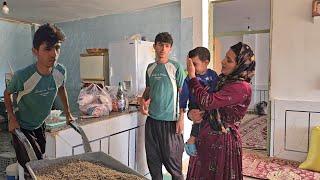
Long, low intensity endurance sessions: When is Low too low? When is Long too long?
Комментарии:

So when we are training in the ever popular zone 2 we should keep lactate between 2mmol and 4mmol? I was under the impression from watching other vids I should stay below 2mmol for zone 2 but your 3 zone chart is a little different.
If I stay under 140bpm I’m under 2mmol. But when I go closer to 150bpm I was close to 4mmol. I am a beginner though. I’ve only been cycling for 6 months now.
I realize we have to train in many different zones. I do intervals and sweetspot training as well.

Great video.
Re: the slide showing the decoupling after coming back from your leg injury, were you riding at 205 in ERG mode or was that just the average power?

Humans have either walked , jogged and sprinted . So the human body must be designed for all 3 of the movements , and ofcourse walking , humans would spend at least 90 percent walking . So our ancestors were probably masters of polarised training 🤔 so I would say your approach to training is spot on
Ответить
how do you incorporate trail riding with variable heart rate into training please?
Ответить
Interesting is that Niels van der Poel build his areaobic capacity for bikini 5-6h at power 205-210 (later it was 235W).even you consider avarage 197W as a too low and waste time-but his must have been even lower as % max heart rate/reserve. But Niels did it over time few times so method works.
Ответить
My question is: Did these athletes start training at a higher HR once they saw that their lactate was only 1.0 after 1-2 hours in order to aim for a lactate of, say 1.8?
Ответить
There are some clues to these questions in the Schantz 1983 paper with cross country skiing 30 hours per week at low intensity and the Dudley 1982 study with rats running on treadmills. I think the Dudley paper has an error in calculating relative intensities, and rats' red fast twitch fibers surprisingly have more cytochrome c than slow-twitch unlike humans, but the graphs are very thought-provoking and educational despite not distinguishing between mitochondria volume and function. It does appear that optimal training for capillary development is complicated, and there's very little research on how to increase stroke volume.
Ответить
It may be that very fit and elite athletes train optimally at lower relative intensities ( relative to max HR, VO2 max, or thresholds) but higher absolute intensities (pace or power). Sedentary people seem to respond faster to higher relative intensities and obviously lower absolute intensities.
Ответить
Not that won't work but way too, too complex ..lol
Ответить
Dear Dr Seiler,
Thank you so much
for an outstanding content.
Also, your speech pattern
and sound quality
make the valuable teaching
easier to absorb.
Thank you for your work.
I subscribed 💚👍

I am probably just thick, but where is it summarised re “how low is too low”? How easy can my easy runs be before they’re no longer effective? I caught the summary at the end too but still left me puzzled as to how to work it out, would have been great if some stock examples were prepared.
I have a max HR of 199.
My resting HR is on average; 58.
This gives me a HRR of 141.
My usual zone 2 runs are 60-75 minutes at 70-78% of Max HR.
How low is too low? How do I work that out?
If I am out with a friend who is slower and my average HR is now 120 or 60% of my max, how long do I need to run for to not make it a waste of time? Or is it never a waste of time at 60% of Max? When is a waste of time? 50% of max?

Do you recommend low-intensity for the long runs >30 k 4-6 weeks before a Marathon or change to tempo runs instead training the race pace? (or both?)?
Ответить
Wonderful, thanks!
Ответить
Question: Fantastic info. HRR seems to give a lot of valuable info . But to calibrate this for runners, what would we use in place of %6minute power? The Apple Watch does provide power data now, and I’m going to assume their power data is close, and if it isn’t, it looks to be at least consistent with HR, effort etc. Is there anything else a runner can use for calibration ? (I don’t want to get the foot pod). Or some other metric besides %6min power?
Ответить
😀
Ответить
Hi Dr. Seiler, thank you for the informative video. I have a bit of a strange situation where 65% (~120W) of my 60 min FTP (189W) results in me having a HR that is about 80% (160BPM) of my max HR (199BPM). Have you ever encountered a case where the disconnect between physiological exertion and power output is so high? Am I just extremely unfit? And if so, would it be wiser to continue training at 65% of my FTP, or to ride at 50% of my HRR (129BPM), which would mean a significantly lower power?
Ответить
I maybe missed informations but is the cadence (rpm) was constant during the steady state tests you discribed ? I don't have that much hr drift (5%) by lowering the cadence on the last intervalls i.e. 4X1h@VT1 ~70%HRmax on the trainer with proper hydratation and food. My legs are tired but my heart, lungs...are good. My VT1 hear rate target is maybe to low ? And I should target higher than 70% ? Thanks a lot for your work ! Hi from France 🚴🚴🚴🚴
Ответить
Great vídeo!!! Very thankful front Venezuela 👏👏👏
Ответить
how to calculate %HRR?
Ответить
%HRR and %6min power is a really interesting metric. I listen to a lot of your videos for my own curiosity, but this one really piqued my interest.
Off-hand, have you seen any exceptions to %HRR and %6min Power not calibrating well in the lab or outdoor setting? I ran the numbers from a recent 5-hour ride and 6-minute effort I did. I was surprised that my %HRR and %6min Power are quite off (9%).
I’d call myself well-trained. On my 5-hour ride, I averaged 215w and only saw my %HRR move from 60.6% to 64.3%. 215w is 52% of 6min power.
Could certain discrepancies in the calibration give an insight to a rider’s physiology that should be influential when designing a training program?

Is it just me, cuz I can’t imagine doing 225W for 2 hours with a heart rate of 114! I do 120W for 1 hour and my HR is 142.
Ответить
In the diagram of iZones you have 1 to 5 and 6+, based on a percentage of HR peak. It's not clear what HR peak is, clearly it can't be HR max as zone 6+ begins at HR peak, and HR max cannot by definition be exceeded. So what is HR peak?
Ответить
very interesting
Ответить
its worth taking a look at Remmert Weilinga s strava. he has most of the climbing koms around monaco and is in his mid 40s! he seams to ride moslty in zone 1 or 2 but puts in a threshold, ie kom effort, every single ride. from 5 mins to an hour at threshold every single ride.
Ответить
40+ yrs training. i find target heart range THR and hydration levels HL are the keys to intensity and duration. Look forward to listening to what you say, just dont have time today
with increasing mileage, THR rises and HL decline more slowly. after 75,000+ miles running, can say it works for me. improving plan for me is 1/4 mile distance increase every 5 days. with cross training (weights/calisthenics) increasing weekly too. current plan is just to see how far i can take it. hehe
i dont believe in running >14mi/day anymore in training as HL cannot be maintained but 2X per day pretty sure i can get well beyond 14/day. Diet composition also very much in my mind every day too. for me, i believe very high hydration and shorter workouts more efficient for faster progress and faster recovery. good luck!

Dr Seiler, At what lactate level would you recommend LIT (4-8h weekly running) to be perforrmed? Your example of shooting at the barn blindfolded is exactly how I feel running at my MAF heartrate.
Ответить
Thank you for the video, Its pleasure to learn the way you present information so calmly. 31-year old amateur cyclist from 6 year ago.
Ответить
Gold.
Ответить
I am a 70 year old cyclist. I do polo rides training and perform my low intensity rides at 60% to 65% of my heart rate reserve. (Rhr 48, max hr 178, hr reserve 130, 60 to 65% 126-133). I only use heart rate since I do not have a power meter. Through the season my speed increases overall and I find that after 2 to 2 1/2 hours of my typical ride my speed decline as I focus on maintaining my target heart rate. First am I calculating my target hr correctly, secondly do you think I should increase my duration throughout the season or accept the increased speed as suitable overload.
Ответить
I have a question: my max HR is 212, but I can only get that after not training for say 2 month (aka out of shape) after 2-4 rest days (well rested) my max HR is 204 should I then use my actual max or the one I usually have?
(For when I am overtraining it goes down to 184 and resting HR goes from 50 -> 60)

Not saying this would be good training for serious athletes but for time crutched people with normal jobs, would a treadmill desk be good enough to reach into zone 2 to get some of the benefits while doing their desk job?
Ответить
Interesting. I am almost 75, my resting HR is 39 (min today 36 for 2 mins whilst asleep) and max 184. Perhaps I'm an outlier.
Ответить
curious about gender differences particularly in relation to hormones, menstrual cycle, and the effect of cortisol levels as a result of these various HR% and lactate shifts etc. essentially, do these same principles apply to women as to men?
Ответить
Thank you for the very interesting content. I have a question about training time in different zones, what if i do a polarized training inside the same session, in the sense that in the same session i train 80% of time in low intensity and the other 20% in high intensity?
Ответить
I didn't find a lot of content in this video related to its title. The lowest low properly looked at is solidly in Z2 of a 5 zone model.
What about 50%HR Max? 30%? 8 hours? 12 hours? Is there an intensity you can do from morning till nightfall and see adaptations? Answer the questions you have posed.

Talks too loud. LOL
Ответить
Do you get similar results if you sleep 2h 2x/day? Tks
Ответить
Interesting video.. makes me wonder about the day after a hard ride, how my HR is significantly depressed.. but it doesn’t mean there isn’t high internal stress, I assume there’s moreso for a given HR.
Ответить
Maybe my heart is just a weirdo... but I'm experiencing (by measuring) reverse cardiac drift every time I get out on a Z2 (5 zones model) endurance ride!
46YO / 180cm / 70Kgs Cyclist here, data freak, Powermeter always in check.
Endurance ride I chose roads that allow me to keep pedaling at a given constant intensity for hours without leaving behind nearly any pedal stroke (no fast descents, no significant traffic intersections), I just keep pedaling.
It happens that after an initial 20-30 minutes warm up in Z1, I start with Z2 (example 175W for me is mid Z2) and my HR reaches a certain value after a few minutes (example 152 bpm, HR Z2,9) and it stays there for the first hour approximately. Then after 1h / 1,5h it starts dropping and it keeps going down the longer I go. In short after 4 or 5 hours of same Z2 power I can end up cycling with a HR value of 142 - 144 (HR Z2,3 - 2,4).
Am I an alien? Or my powermeter is to be trashed?
Stephen, any experience with such cardiac behavior within your researches?
Thanks for sharing all this good stuff with us!

Very interesting presentation! However, I have an interesting thing going on that just started happening over the last couple of months.
Not only does my heart rate drift upward over time, but there are times my heart will fluctuate up to +/- 20 bpm in a matter of seconds. It seems to occur more frequently after an interval set, after any harder effort, or after higher drift has started. During the harder efforts, my heart beats fast, but regular. As soon as I back off the effort or drift starts and I maintain a consistent power, my heart will start this irregular pattern for as much as 5 minutes or until I increase the effort again or back off more. I feel the heart doing this, but I never feel the effects. Is this fluctuation range something to worry about? I saw my Cardiologist. He didn't worry about it, but asked me if I wanted to wear a monitor. I see him again in a couple of months. So, I wanted to wait and watch forst. I have a fan that adjusts based on heart rate and am curious if this could contribute to this? I try to pay attention to it, but I am not certain. As my heart rate increases, my fan blows harder at prescribed heart rate levels. As the fan blows harder, the skin cools faster. As a result, the heart rate slows because the cooling need is reduced. The fan then slows, leading to the skin warming back up. If I stay at the easier pace, my core cools enough that my heart rate no longer needs to respond to temperature change.
Sorry for the lengthy post! However, this is a strange one for me.

Absolutely amazing stuff
Ответить
That's very helpful. But sadly for me that means I won't be able to make significant progress because my overall training time is limited.
Ответить
Some really interesting stuff here. When considering factors that determine IN/EX_S time of onset and magnitude, loss of ions (notably Na, K, Mg) through perspiration could also play a role.
Ответить
I wish I have found your work earlier. I mean not some month earlier, earlier in life. I stopped running 11 years ago. Training was like all out for 1 hour, 6-7 days a week. Idiotic. I tried running at lower heart rate some times, it seems not to be possible. 170 felt just fine untill it did not :-). So I am 51 now. LT1 ist 154, HRmax193. I can run, row and bike well below LT1/VT1 for 1-2 hours. I sleep well and recovery is done less than 24 hours after training. VO2max goes up, times get better on the same HR. I do not think I will win anything in the future but I like the training and I feel good in general.
Ответить

























